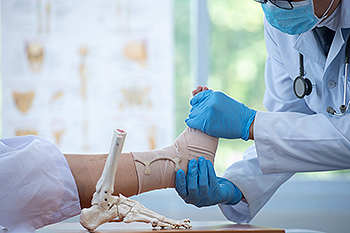
Anyone who has broken their ankle knows how uncomfortable it can be. It is also known as a fractured ankle, and in most cases, it can be extremely difficult to walk. There are three bones that the ankle is comprised of, which are the tibia, fibula, and talus. The larger bone in the lower leg is referred to as the tibia, and the calf bone is called the fibula. This is the smallest bone in the lower leg, and the talus bone is located between the tibia and fibula. Any one of these bones can break during a foot injury, and a popping sound may be heard at the time. Additional symptoms can include immediate bruising, severe pain, and discomfort, and the foot may turn a blue or purplish color. Temporary relief may be found when the affected foot is elevated until a proper diagnosis can be performed. This involves having an X-ray taken, followed by wearing a cast or protective boot. The recovery period is approximately eight weeks, and it is suggested that you initially consult with a podiatrist who can properly treat a broken ankle.
Broken ankles need immediate treatment. If you are seeking treatment, contact Bruce Smit, DPM from Frankfort Foot & Ankle Clinic. Our doctor can provide the care you need to keep you pain-free and on your feet.
Broken Ankles
A broken ankle is experienced when a person fractures their tibia or fibula in the lower leg and ankle area. Both of these bones are attached at the bottom of the leg and combine to form what we know to be our ankle.
When a physician is referring to a break of the ankle, he or she is usually referring to a break in the area where the tibia and fibula are joined to create our ankle joint. Ankles are more prone to fractures because the ankle is an area that suffers a lot of pressure and stress. There are some obvious signs when a person experiences a fractured ankle, and the following symptoms may be present.
Symptoms of a Fractured Ankle
If you suspect an ankle fracture, it is recommended to seek treatment as soon as possible. The sooner you have your podiatrist diagnose the fracture, the quicker you’ll be on the way towards recovery.
If you have any questions, please feel free to contact our office located in Frankfort, IL . We offer the newest diagnostic and treatment technologies for all your foot care needs.
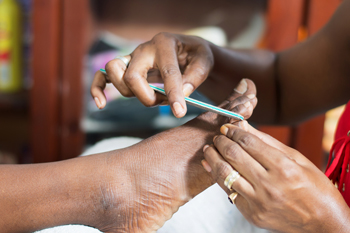
Many people connect that the quality of their life is based on how good their feet feel. They are the foundation of the body, and completing daily activities may be difficult with aching feet. Additionally, poor foot health may limit exercise completely, or limit the amount of time spent practicing it. There are simple habits that can ensure healthy feet when everyday foot care techniques are enforced. These start with washing and drying the feet thoroughly, followed by applying a good moisturizer on them. It is beneficial to have the toenails properly trimmed, and this can be done by having regular pedicures done, or by cutting them at home using a stainless steel clipper. The feet will feel good when they are soaked in warm water at the end of the day, which may have a soothing effect on the overall body. Additionally, the type of shoes that are worn contributes significantly to how the feet feel. It is beneficial to wear shoes that are the correct size, have ample room for the toes to move freely in, and are comfortable. If you would like to have additional tips on following a daily foot care routine, please confer with a podiatrist.
Everyday foot care is very important to prevent infection and other foot ailments. If you need your feet checked, contact Bruce Smit, DPM from Frankfort Foot & Ankle Clinic. Our doctor can provide the care you need to keep you pain-free and on your feet.
Everyday Foot Care
Often, people take care of their bodies, face and hair more so than they do for their feet. But the feet are a very important aspect of our bodies, and one that we should pay more attention to. Without our feet, we would not be able to perform most daily tasks.
It is best to check your feet regularly to make sure there are no new bruises or cuts that you may not have noticed before. For dry feet, moisturizer can easily be a remedy and can be applied as often as necessary to the affected areas. Wearing shoes that fit well can also help you maintain good foot health, as well as making it easier to walk and do daily activities without the stress or pain of ill-fitting shoes, high heels, or even flip flops. Wearing clean socks with closed shoes is important to ensure that sweat and bacteria do not accumulate within the shoe. Clean socks help to prevent Athlete’s foot, fungi problems, bad odors, and can absorb sweat.
If you have any questions please feel free to contact our office located in Frankfort, IL . We offer the newest diagnostic and treatment technologies for all your foot and ankle needs.
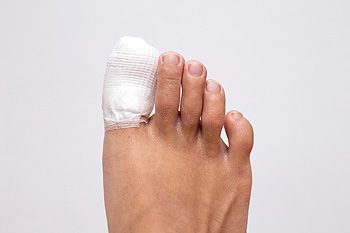
Almost everyone is familiar with the pain that can result from stubbing one’s toe. For example, when an individual suddenly jams their toe into a hard surface, such as the leg of a table or a door frame, they might experience sharp sudden pain. Severe cases of stubbed toes can result in further injuries, such as a broken toe. In these cases, the bones in the toes will break. There are several ways to identify a broken toe. You might notice swelling at the toe, discoloration, difficulty moving the toe, and even numbness. Although a broken toe might not sound serious to some people, it is nothing to take lightly. If you have stubbed your toe and begin to notice these symptoms, it is wise to contact a podiatrist immediately. This foot specialist will help you identify and treat the problem in your feet.
A broken toe can be very painful and lead to complications if not properly fixed. If you have any concerns about your feet, contact Bruce Smit, DPM from Frankfort Foot & Ankle Clinic. Our doctor will treat your foot and ankle needs.
What to Know About a Broken Toe
Although most people try to avoid foot trauma such as banging, stubbing, or dropping heavy objects on their feet, the unfortunate fact is that it is a common occurrence. Given the fact that toes are positioned in front of the feet, they typically sustain the brunt of such trauma. When trauma occurs to a toe, the result can be a painful break (fracture).
Symptoms of a Broken Toe
Generally, it is best to stay off of the injured toe with the affected foot elevated.
Severe toe fractures may be treated with a splint, cast, and in some cases, minor surgery. Due to its position and the pressure it endures with daily activity, future complications can occur if the big toe is not properly treated.
If you have any questions please feel free to contact our office located in Frankfort, IL . We offer the newest diagnostic and treatment technologies for all your foot and ankle needs.
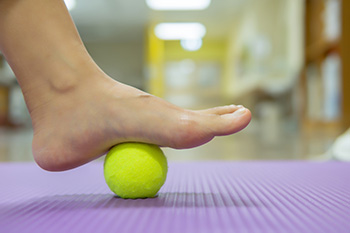
Many people have chronic foot pain and find comfort in strengthening their feet. This is done by performing specific stretches and exercises that are simple to do. Increased foot strength can reduce the risk of injury and may improve existing foot structure. A tennis ball is an effective tool to strengthen the entire foot. An exercise using a tennis ball is simply done by rolling the foot from the toes to the heel over the tennis ball or similar object. This can help to keep the muscles and tendons surrounding the arch to remain strong, which may alleviate general foot pain. The heels and calf muscles can become stronger by standing on a step while lowering the heels one at a time until a gentle stretch is felt. Stretching the toes can be easy to do, and is done by picking up marbles that are on the floor with the toes. Additionally, this is also an effective stretch for the entire foot. If you would like more information about the benefits of exercising the feet, and how to perform specific stretches, please schedule an appointment with a podiatrist.
Exercising your feet regularly with the proper foot wear is a great way to prevent injuries and build strength. If you have any concerns about your feet, contact Bruce Smit, DPM from Frankfort Foot & Ankle Clinic. Our doctor can provide the care you need to keep you pain-free and on your feet.
Exercise for Your Feet
Exercise for your feet can help you gain strength, mobility and flexibility in your feet. They say that strengthening your feet can be just as rewarding as strengthening another part of the body. Your feet are very important, and we often forget about them in our daily tasks. But it is because of our feet that are we able to get going and do what we need to. For those of us fortunate enough to not have any foot problems, it is an important gesture to take care of them to ensure good health in the long run.
Some foot health exercises can include ankle pumps, tip-toeing, toe rises, lifting off the floor doing reps and sets, and flexing the toes. It is best to speak with Our doctor to determine an appropriate regimen for your needs. Everyone’s needs and bodies are different, and the activities required to maintain strength in the feet vary from individual to individual.
Once you get into a routine of doing regular exercise, you may notice a difference in your feet and how strong they may become.
If you have any questions please feel free to contact our office located in Frankfort, IL . We offer the newest diagnostic and treatment technologies for all your foot and ankle needs.

The common fungal infection known as athlete’s foot can be quite uncomfortable. This fungal infection affects the skin on the feet, and can cause severe itchiness between the toes. Other symptoms can include dry skin and redness on the bottom of the feet. In severe cases, the toenails may be affected, and toenail fungus may develop. This fungus lives and thrives in warm and moist environments, including shower room floors, locker rooms, public swimming pools, and surrounding areas. These are areas where many people walk barefoot, and the fungus can enter the body through small cuts in the bottom of the feet. Athlete's foot is considered to be contagious and effective prevention methods can include wearing appropriate shoes while in these areas and refraining from sharing shoes, socks, and towels. Many people who have athlete's foot seek prompt medical attention, which is beneficial in successfully curing this condition. If you are afflicted with athlete's foot, please consult a podiatrist for treatment.
Athlete’s foot is an inconvenient condition that can be easily reduced with the proper treatment. If you have any concerns about your feet and ankles, contact Bruce Smit, DPM from Frankfort Foot & Ankle Clinic. Our doctor will treat your foot and ankle needs.
Athlete’s Foot: The Sole Story
Athlete's foot, also known as tinea pedis, can be an extremely contagious foot infection. It is commonly contracted in public changing areas and bathrooms, dormitory style living quarters, around locker rooms and public swimming pools, or anywhere your feet often come into contact with other people.
Solutions to Combat Athlete’s Foot
Athlete’s foot can cause many irritating symptoms such as dry and flaking skin, itching, and redness. Some more severe symptoms can include bleeding and cracked skin, intense itching and burning, and even pain when walking. In the worst cases, Athlete’s foot can cause blistering as well. Speak to your podiatrist for a better understanding of the different causes of Athlete’s foot, as well as help in determining which treatment options are best for you.
If you have any questions please feel free to contact our office located in Frankfort, IL . We offer the newest diagnostic and treatment technologies for all your foot and ankle needs.

As winter approaches, it can bring with it an increase in pain and inflammation in people with arthritis. This is believed to be caused by changes in barometric pressure rather than by cold and damp climates. When the barometer is up, the pressure pushes against the body and keeps tissues from expanding. The opposite is true when the barometer drops. The lower pressure allows the tissues to expand and they in turn put pressure on the nerves that transmit feelings of pain. This explains why many people with arthritis say they can predict a storm. They feel the pain as the barometer drops. Physical activity can help to reduce joint pain and increase flexibility. Experts suggest keeping active during colder months by walking indoors and wearing looser layers of clothing to trap body heat. Wearing socks and waterproof boots are recommended if you are outdoors. See a podiatrist for further information on how to manage your arthritis pain.
Arthritis can be a difficult condition to live with. If you are seeking treatment, contact Bruce Smit, DPM from Frankfort Foot & Ankle Clinic. Our doctor can provide the care you need to keep you pain-free and on your feet.
Arthritic Foot Care
Arthritis is a term that is commonly used to describe joint pain. The condition itself can occur to anyone of any age, race, or gender, and there are over 100 types of it. Nevertheless, arthritis is more commonly found in women compared to men, and it is also more prevalent in those who are overweight. The causes of arthritis vary depending on which type of arthritis you have. Osteoarthritis for example, is often caused by injury, while rheumatoid arthritis is caused by a misdirected immune system.
Symptoms
Arthritic symptoms range in severity, and they may come and go. Some symptoms stay the same for several years but could potentially get worse with time. Severe cases of arthritis can prevent its sufferers from performing daily activities and make walking difficult.
Risk Factors
If you suspect your arthritis is affecting your feet, it is crucial that you see a podiatrist immediately. Your doctor will be able to address your specific case and help you decide which treatment method is best for you.
If you have any questions, please feel free to contact our office located in Frankfort, IL . We offer the newest diagnostic and treatment technologies for all your foot care needs.
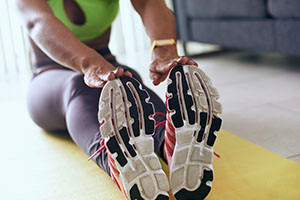
People that have fitness goals realize getting injured can be a huge setback and will disrupt completing goals on time. Preventing running injuries is an integral part of staying fit and healthy, and there are simple methods that can be implemented to accomplish this. It is important to take a day off from your chosen sport as this can give the body ample time to rest. When the training is intense, it is beneficial to follow an easier workout the next day, allowing the legs and body to recover. Research has indicated how important sleep is for physically fit individuals and cardiovascular performance may be hindered if sleep is deprived on a routine basis. Warming up and cooling down is an essential part of any workout routine because it provides the muscles with increased blood flow, in addition to alleviating muscle stiffness. There are several ways running injuries can affect the feet so it is suggested that you confer with a podiatrist who can guide you on additional methods for how to prevent them.
Exercising your feet regularly with the proper foot wear is a great way to prevent injuries. If you have any concerns about your feet, contact Bruce Smit, DPM of Frankfort Foot & Ankle Clinic. Our doctor will treat your foot and ankle needs.
How to Prevent Running Injuries
Many common running injuries are caused by overuse and overtraining. When the back of the kneecap starts wearing out and starts causing pain in your knee, this is commonly referred to as runner’s knee. Runner’s knee is a decrease in strength in your quadriceps and can occur if you’re not wearing properly fitted or supporting shoes. To prevent runner’s knee, focusing on hip strengthening is a good idea, as well as strengthening your quads to keep the kneecaps aligned.
What Are Some Causes of Running Injuries?
- One cause of a common running injury is called iliotibial band syndrome.
- Plantar fasciitis is also another common injury.
- Stress fractures can occur from overtraining, lack of calcium, or even your running style.
Best Ways to Prevent Running Injuries
- Wear footwear that fits properly and suits your running needs.
- Running shoes are the only protective gear that runners have to safeguard them from injury.
- Make a training schedule. Adding strengthening exercises as well as regular stretching can help keep you strong and limber and can lessen the possibility of injuries.
- Stretching keeps muscles limber; this will help you gain better flexibility.
If you have any questions please feel free to contact our office located in Frankfort, IL . We offer the newest diagnostic and treatment technologies for all your foot and ankle needs.
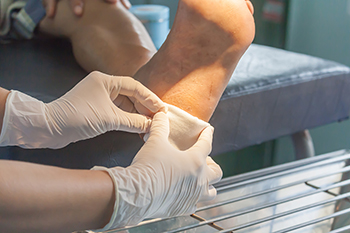
The risk of infection from a wound on the foot may be reduced when it is cleaned properly. The wound can be cleaned by rinsing it under running water for several minutes and covering it with a gauze pad. This is generally followed by applying a protective covering that is adequate to stop existing bleeding. If the wound is severe, pressure may be applied temporarily which may help to control bleeding. Diabetic patients may develop wounds on the feet more frequently than other patients. This may be a result of the inability to feel cuts, bruises, or wounds on the feet because neuropathy may be present. Wounds on the feet can be a serious matter, and it is strongly advised that you are under the care of a podiatrist who can properly evaluate why the wound and treat it accordingly.
Wound care is an important part in dealing with diabetes. If you have diabetes and a foot wound or would like more information about wound care for diabetics, consult with Bruce Smit, DPM from Frankfort Foot & Ankle Clinic. Our doctor will assess your condition and provide you with quality foot and ankle treatment.
What Is Wound Care?
Wound care is the practice of taking proper care of a wound. This can range from the smallest to the largest of wounds. While everyone can benefit from proper wound care, it is much more important for diabetics. Diabetics often suffer from poor blood circulation which causes wounds to heal much slower than they would in a non-diabetic.
What Is the Importance of Wound Care?
While it may not seem apparent with small ulcers on the foot, for diabetics, any size ulcer can become infected. Diabetics often also suffer from neuropathy, or nerve loss. This means they might not even feel when they have an ulcer on their foot. If the wound becomes severely infected, amputation may be necessary. Therefore, it is of the upmost importance to properly care for any and all foot wounds.
How to Care for Wounds
The best way to care for foot wounds is to prevent them. For diabetics, this means daily inspections of the feet for any signs of abnormalities or ulcers. It is also recommended to see a podiatrist several times a year for a foot inspection. If you do have an ulcer, run the wound under water to clear dirt from the wound; then apply antibiotic ointment to the wound and cover with a bandage. Bandages should be changed daily and keeping pressure off the wound is smart. It is advised to see a podiatrist, who can keep an eye on it.
If you have any questions, please feel free to contact our office located in Frankfort, IL . We offer the newest diagnostic and treatment technologies for all your foot care needs.